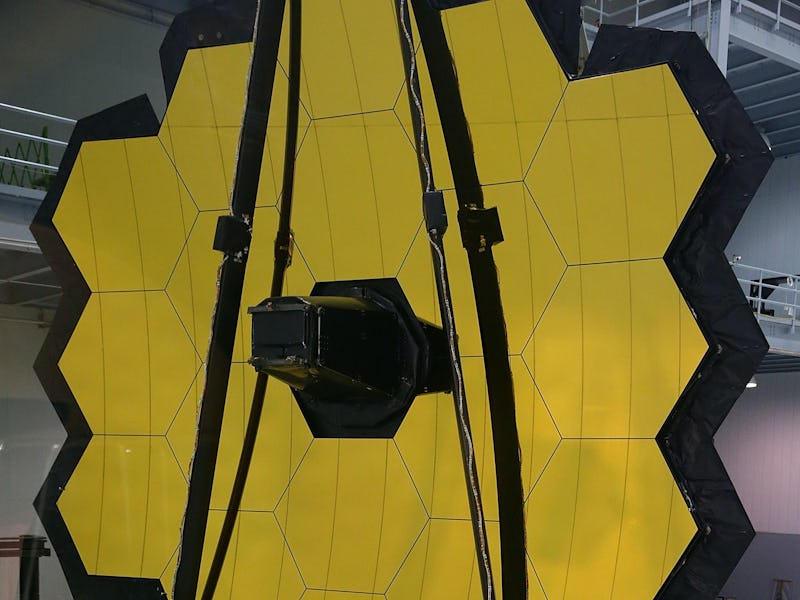Webb Telescope launch date delayed: Everything you need to know
Will the James Webb Space Telescope still make it into orbit this year?

After 31 years of service, the Hubble Space Telescope is getting a successor — eventually. The James Webb Space Telescope is scheduled to launch into Earth’s orbit this year, expanding our capability to see far-off celestial bodies. However, NASA just announced the latest delay for the perpetually behind schedule telescope.
The task of launching a new space telescope hasn’t been easy. The Webb project is nearly $8 billion over budget and 14 years late — when considering the most optimistic cost and ambitious timeline detailed by the Government Accountability Office. However, there’s now the potential that the Ariane 5 rocket slated to carry the Webb into orbit might be the cause of further delay.
But the Webb itself has now begun to pass final mechanical tests, necessary before a trip to its launch site at Europe’s Spaceport in South America’s French Guinea. And with the telescope itself nearly ready to launch, it seems the project’s delays might be coming to an end.
Before then, however, the Webb is getting delayed at least one more time.
When is the Webb Telescope launch date?
Until recently, the Webb Telescope was scheduled to launch on October 31, but it was recently pushed to November or even December. In a press conference on June 1, the telescope's director for launch services, Beatriz Romero explained that multiple factors caused NASA to postpone the launch once again.
UPDATE: The European Space Agency recently announced a new targetted launch date of December 18, 2021.
The reasons behind the Webb’s latest delay include issues with the Ariane 5 rocket, along with the process of transporting the telescope and the status of the South American spaceport where it’s set to launch.
Romero added that we likely won’t get a new Webb Telescope launch date until late summer or even early fall.
What is the James Webb Space Telescope?
The Webb essentially looks like an enormous honeycomb surfing on top of a coffin. The telescope’s primary mirror consists of 18 hexagonal pieces, which are made of beryllium and coated with highly polished gold. They form a large, roughly circular honeycomb shape. A small secondary mirror reflects the collected light into the center of the honeycomb, where it is interpreted into images by the Webb’s infrared sensors.
The bottom of the Webb, which the honeycomb rides atop, acts as a shade to prevent interference from our sun. It also hosts an Earth-facing antenna to send data back home, as well as smaller telescopes, a stabilization flap, the satellite’s computers, and a solar array.
The mirror is too large to launch in its full glory, so parts of it must be folded backwards to fit inside the Ariane 5’s 16-foot wide fairing. It requires 132 actuators to unfold and focus the mirror after the telescope is deployed. Crucially, the Webb recently aced its final unfolding test, one of the conditions for a timely launch.
What will the Webb Telescope be able to see?
The Hubble telescope allows us to peer into the visible, ultraviolet, and infrared light produced by the universe, and its discoveries have led to more than 18,000 peer-reviewed scientific papers, according to NASA.
The Webb will be more specialized to detect infrared light, which could unlock new discoveries about earlier galaxies. As the universe expands, Einstein’s theory of relativity describes the space between objects expanding and stretching as well. Light waves in that expanding space, traveling for billions of years, stretch as well. These waves fall out of the visible spectrum and into the infrared spectrum, meaning a sensitive infrared instrument could pick up what visible or ultraviolet sensors couldn’t.
We also now know what science the Webb will conduct in its first year. The Space Telescope Science Institute, the international body charged with building and running the telescope, has now released a list of experiments approved for time on the telescope. The experiments are divided into three categories: General Observer programs, which are peer-reviewed proposals from the scientific community at large; Guaranteed Time Observations, for those who contributed to building the telescope, and Early Release Science, which are smaller projects intended for the first five months of the Webb’s life.
These experiments span the celestial gamut, from studying supermassive black holes to “trace species and hydrated features” (read: life and water) on Mars.
Hubble Telescope vs. Webb Telescope
The Hubble Telescope.
The Webb features a 6.5-meter mirror array (compared to the Hubble’s 2.4-meter), giving the new telescope a much greater ability to gather the faint light emanating from the far reaches of space.
The Webb Telescope will specialize in recording infrared light, rather than the optical, ultraviolet, and limited infrared capabilities of the Hubble. This specialization allows the Webb to study earlier galaxies than previously visible, as well as take advantage of infrared light’s ability to cut through dust and debris floating in space.
What happens to the Hubble Telescope now?
All you Hubble-heads don’t need to worry. The Webb doesn’t mean that the Hubble is going to be immediately obsolete.
The Hubble is expected to survive until at least 2026, Tom Brown, the head of the Hubble Space Telescope mission, told MIT Tech Review earlier this year. So rather than purposefully stopping the Hubble mission, the most likely scenario would be a critical malfunction that the team couldn’t get funding to fix.
But in the meantime, the Hubble will still be conducting science as well. Since the Webb’s primary focus is deep space and infrared light, the Hubble’s optical sensors are still important for getting more traditional images of space.
“Hubble is really the premier game for doing ultraviolet and optical astronomy,” Brown said. “So much of astronomy, especially when it comes to understanding temperature and chemistry in outer space, hinges on the information you can really get from it.”